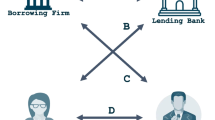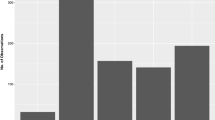Abstract
This paper analyzes data from a regional Italian bank to provide new evidence on the relationship between who, within a bank, approves a loan and the subsequent performance of the loan. The size of the bank and its pool of clients, who are primarily small- and medium-size firms, comprises characteristics of both relationship-based and transaction-based lending technologies. Our key finding is that the probability of loan default increases as the loan approval decision is made at higher levels of the lending-decision hierarchy. This evidence supports the primacy of relationship-lending technology relative to transaction-based lending technology.
Similar content being viewed by others
Notes
Relationship lending plays also a role in determining firms’ capital structure. Guida and Sabato (2017) use a unique dataset of European manufacturing firms, and measure relationship lending based on three dimensions (closeness, soft information, exclusivity) and relate them to firms’ leverage. The authors find that the actual use of soft information increases leverage and only firms without soft information-intensive relationships increase their leverage through multiple relationships.
As for the two lending technologies, with respect to their relative efficiency in the allocation of resources, it would be more appropriate to compare their benefits and costs and not simply their relative default probabilities. Indeed, assuming that transaction-based lending technologies are cheaper than relationship technologies, if the savings from the former are large enough to compensate the additional costs associated their higher default probabilities, transaction-based lending technologies should be preferred to relationship technologies.
Initiatives of structural banking refer to the “Volcker rule” in the U.S. and to the proposals of the Vickers Commission for the UK. In Europe, there is no agreement on the idea to revise the model of universal banking, as banks should be free to choose which business model to adopt. See Gambacorta and van Rixtel (2013) for a survey on the main reforms.
AIDA covers 1 million Italian companies, and contains their detailed accounting information following the scheme of the 4th Directive CEE, plus indicators and trade description; information on ownership and managers and scanned images of accounts with additional notes. The cost of using this additional source of information was the drop in the number of observations (from 17,641 firms and 136,095 loan records to 3425 customers and 18,658 loan records).
Some bank data are available only for the restricted sample, and are information related to the presence of guarantees, and to other services. The “Appendix” describes why and how we used a smaller database to estimate Model 1.
The percentage of loan defaults are much higher in the total dataset because of the presence of micro firms, which were the most hit by the recession (5.15, 5.63 and 12.93% in 2010, 2011 and 2012, respectively).
Italy GDP fell by 2.4% in 2012.
Observations of firms already in default at the time of loan application are not included in the sample used to estimate Model 1.
The bank President, i.e., the President of the Board of Directors, has the authority to approve a loan under unique circumstances and at short notice.
We control for firm size, by means of number of employees (log), roa, and net income, alternatively. We also checked whether firm leverage could affect our results. Our findings are overall confirmed. Estimates are available upon request from the authors.
In the Probit estimates of columns (6) and (8) of Table 6, the regression sample reduces to 15,103 observations and 2769 firms as some industry dummies predict failure perfectly. Industries are: mining and quarrying; electricity, gas, steam and air-conditioning supply; water supply, sewerage, waste management and remediation; accommodation and food service activities; information and communication; professional, scientific and technical activities; arts, entertainment and recreation; other services; Activities of extra-territorial organisations and bodies. The industry dummy for Financial and insurance activities has been omitted because of collinearity.
We estimated a reduced version of Model 1 for the total firm sample (see “Appendix”) for which we have a smaller number of control variables (rating, loan size, and year). Our findings are confirmed: the estimated coefficients of each decisional level are still positive and statistically significant, and of larger size with respect to those shown in Tables 6 and 7, which should limit concerns for possible selection bias effects. Estimates available upon request from the authors.
The estimated coefficient of Headquarter Managers and the General Director variables fail to be statistically significant once we control for year effects. One tentative explanation is that both the Headquarter Managers and the General Director approved loans to those firms that were most affected by the recession.
As described above, Initial Rating is a step variable and runs from 1 to 6(5) with higher values meaning a larger default probability.
References
Agarwal, S., & Hauswald, R. (2010). Distance and Private Information in Lending. Review of Financial Studies, 23: 2757–2788.
Alessandrini, P., Calcagnini, G. & Zazzaro, A. (2008). Asset restructuring strategies in bank acquisitions: does distance between dealing partners matter? Journal of Banking & Finance, 32(5): 699–713.
Alessandrini, P., Presbitero, A. F., & Zazzaro, A. (2009). Banks, distances and firms’ financing constraints. Review of Finance, 13(2): 261–307.
Badulescu, D. (2012). SMEs relationship banking: Length, loyalty, trust: Do SMEs get something in return? International Journal of Economics and Management Engineering, 6(6), 1038–1045.
Bank of Italy. (2012). Relazione Annuale Sull’anno 2011. Roma: Bank of Italy.
Bank of Italy. (2013). Relazione Annuale Sull’anno 2012. Roma: Bank of Italy.
Bartoli, F., Ferri, G., Murro, P., & Rotondi, Z. (2013). SME financing and the choice of lending technology in Italy: complementarity or substitutability? Journal of Banking & Finance, 37(12): 5476–5485.
Berger, A. N., & Udell, G. F. (1992). Some evidence on the empirical significance of credit rationing. Journal of Political Economy, 100(5), 1047–1077.
Berger, A. N., & Udell, G. F. (2006). A more complete conceptual framework for SME finance. Journal of Banking & Finance, 30(11), 2945–2966.
Berlin, M., & Mester, L. J. (1999). Deposits and relationship lending. The Review of Financial Studies, 12(3): 579–607
Bolton, P., Freixas, X., Gambacorta, L., & Mistrulli, P. E. (2016). Relationship and transaction lending in a crisis. The Review of Financial Studies, 29(10): 2643–2676.
Boot, A. W. A. (2000). Relationship banking: What do we know? Journal of Financial Intermediation, 9(1), 7–25.
Boot, A. W. A., & Thakor, A. V. (1994). Moral hazard and secured lending in an infinitely repeated credit market game. International Economic Review, 20, 503–529.
Brighi, P., Lucarelli, C., & Venturelli, V. (2017). The relative predictive strength of different lending technologies in funding smes. Mimeo.
Calcagnini, G., Farabullini, F., & Giombini, G. (2014). The impact of guarantees on bank loan interest rates. Applied Financial Economics, 24, 397–412.
Calcagnini, G., Giombini, G., & Lenti, E. (2015). Gender differences in bank loan access. An Empirical Analysis. Italian Economic Journal, 1, 193–217.
Cole, R., Goldberg, L., & White, L. (2004). Cookie cutter vs. character: The micro structure of small business lending by large and small banks. Journal of Financial and Quantitative Analysis, 39, 227–250.
Cole, R., Wolken, J. D. (1995). Financial services used by small businesses: evidence from the 1993 National Survey of Small Business Finances, Federal Reserve Bulletin, Board of Governors of the Federal Reserve System (U.S.), issue Jul, pp. 629–667.
Gambacorta, L. (2016). Relationship and transaction lending: New evidence and perspectives. Emerging Markets Finance and Trade, 52(1), 70–75.
Gambacorta, L., van Rixtel, A. (2013). Structural bank regulation initiatives: Approaches and implications. In BIS Working Papers 412, Bank for International Settlements, Basel.
Guida, R., & Sabato, V. (2017). Relationship lending and firms’ leverage: empirical evidence in Europe. European Financial Management, 23(4): 807–835. https://doi.org/10.1111/eufm.12109
Hernández-Cánovas, G., & Martínez-Solano, P. (2010). Relationship lending and SME financing in the continental European bank-based system. Small Business Economics, 34, 465–482. https://doi.org/10.1007/s11187-008-9129-7.
ISTAT. (2009). Classificazione Delle Attività Economiche Ateco 2007. Metodi e Norme No. 40. Roma: ISTAT.
Liberti, J. M., & Mian, A. R. (2009). Estimating the effect of hierarchies on information use. Review of Financial Studies, 22, 4057–4090.
Manove, M., Padilla, A. J., & Pagano, M. (2001). Collateral versus project screening: A model of lazy banks. RAND Journal of Economics, 32(4), 726–744.
Petersen, M. A., & Rajan, R. G. (1995). The effect of credit market competition on lending relationships. The Quarterly Journal of Economics, 110(2), 407–443.
Qian, J., Strahan, P. E., & Yang, Z. (2015). The impact of incentives and communication costs on information production and use: evidence from bank lending. The Journal of Finance, 70(4): 1457–1493.
Rajan, R. G. (1992). Insiders and outsiders: The choice between informed and arm’s-length debt. The Journal of Finance, 47(4), 1367–1400.
Sharpe, S. A. (1990). Asymmetric information, bank lending, and implicit contracts: A stylized model of customer relationships. The Journal of Finance, 45(4), 1069–1087.
Uchida, H., Udell, G. F., & Yamori, N. (2006). SME financing and the choice of lending technology. Technical Report 06-E-025, RIETI Discussion Paper Series 06-E-025.
Uchida, H., Udell, G. F., & Yamori, N. (2012). Loan officers and relationship lending to SMEs. Journal of Financial Intermediation, 21(1): 97–122
Acknowledgements
The authors thank Bob Chirinko, two anonymous referees, and participants at the International Conference on Small Businesses, Banks, Finance, Innovation and Growth held in Urbino, 12-13 October 2017, for helpful comments and suggestions. The usual disclaimers apply.
Author information
Authors and Affiliations
Corresponding author
Appendix: Database construction
Appendix: Database construction
The database was constructed by means of the following steps:
-
1.
Extraction of all deliberated loan records from the original database provided by the regional bank for the period 1/1/2010 − 31/12/2012: nr. 273,699 loans, for a total of nr. 109,148 customers;
-
2.
From the total number of loans, we dropped those (nr. 56,148) for which the delta debt (i.e.: the variation between the initial debt and the requested amount of final debt) was equal to zero. These records usually refer to internal procedures the bank uses to control its clients. Thus, the final dataset at this stage contains 217,551 records and 100,825 customers, of which 17,641 are firms and 136,095 the corresponding records;
-
3.
In the next step we merged the database with information (balance sheet data) coming from the AIDA (Italian company information and business intelligence) dataset for the Region where the bank headquarters are located. AIDA covers 1 million Italian companies, and contains their detailed accounting information following the scheme of the fourth Directive CEE, plus indicators and trade description; information on ownership and managers and scanned images of accounts with additional notes. The cost of using this additional source of information was the drop in the number of observations (from 136,095 to 18,658 loan records and from 17,641 to 3425 firms);
-
4.
The bank provided information on the presence of guarantees and on the presence of other services only for the matched sample.
Rights and permissions
About this article
Cite this article
Calcagnini, G., Cole, R., Giombini, G. et al. Hierarchy of bank loan approval and loan performance. Econ Polit 35, 935–954 (2018). https://doi.org/10.1007/s40888-018-0109-3
Received:
Accepted:
Published:
Issue Date:
DOI: https://doi.org/10.1007/s40888-018-0109-3




